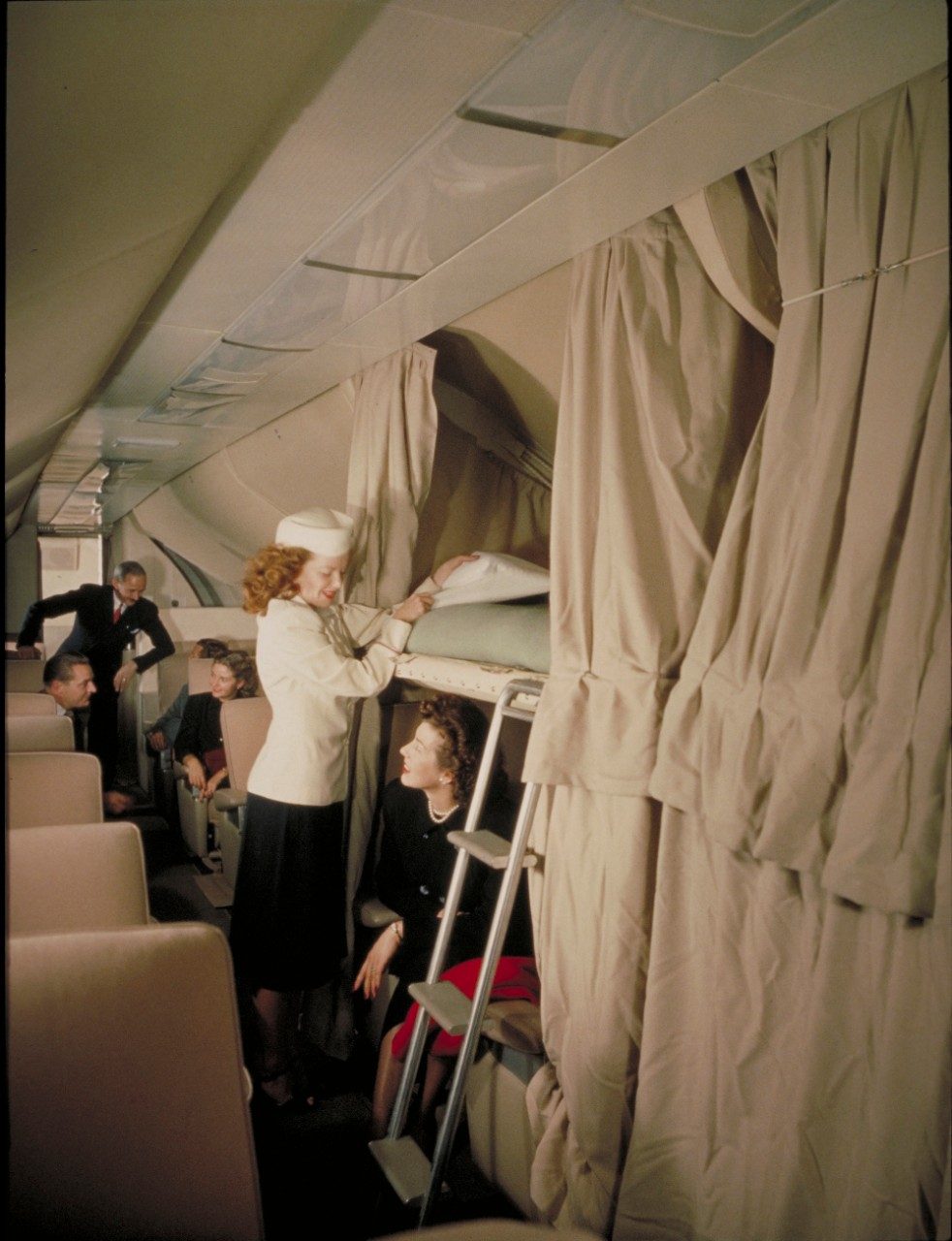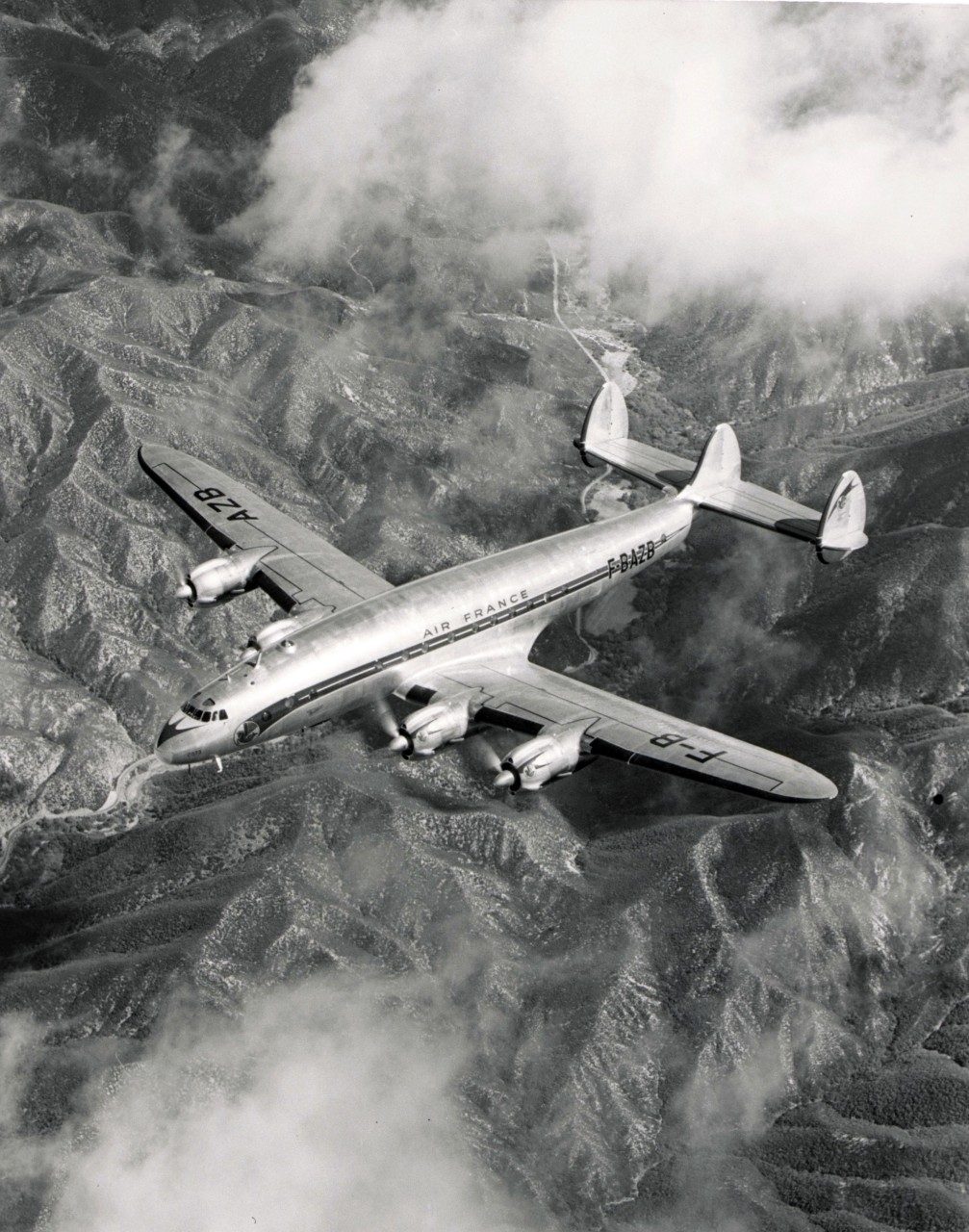In 1939, the top brass of the Lockheed Corporation—president Robert Gross, chief engineer Hall Hibbard, and chief research engineer Kelly Johnson—scheduled a key meeting with a VIP, a man with deep pockets who had recently shown an interest in buying not just one or a handful of new planes but a fleet of them.
The customer’s request had been ambitious. He hoped to hire Lockheed to design a revolutionary aircraft capable of comfortably shuttling 20 passengers and 6,000 pounds of cargo across the United States, offering commercial aviation’s first coast-to-coast, non-stop service.
But the Lockheed team had come to express even grander ambitions. They wanted to build the company’s first large transport, one that “would carry more people farther and faster than ever before, and economically enough to broaden the acceptance of flying as an alternative to train, ship and automobile,” said Johnson.
In the years to come, the plane would be named the Constellation—Connie for short—and be flown by airlines around the world, as well as the U.S. military over the ensuing three decades. Eventually, it would be remembered as an enduring symbol, the epitome of grace in propeller-driven aircraft. But at that moment in 1939 in Los Angeles, the Lockheed Corporation was focused on winning over one customer and one customer only. His name was Howard Hughes.
The Secret Weapon
Having purchased a majority stake in TWA airlines earlier that year, Hughes saw the Constellation as his secret weapon in stealing market share from his competitors. He treated the project with all the subterfuge that secret weapons require. Not only did he demand total secrecy, but also specified that Lockheed could not sell the aircraft to any other transcontinental airline until TWA had received 35 of them.
Hughes outlined the initial performance specifications, but it was Lockheed that would design the sleek, distinctive, now-iconic aircraft. It was a critical turning point for Lockheed. As Hibbard said, “Up to that time we were sort of ‘small-time guys,’ but when we got to the Constellation we had to be ‘big time guys’ … We had to be right and we had to be good.”
Being good meant introducing new features previously unseen on passenger planes. The Constellation would offer the first hydraulically boosted power controls, aviation’s equivalent of power steering. It would be faster than most World War II fighters at 350 mph. And, using award-winning technology pioneered by Lockheed a few years earlier, it would feature a pressurized cabin for 44 passengers that allowed the plane to fly faster and above 90 percent of weather disturbances, what Constellation regulars would come to call smooth sailing.
A Record Breaker
In fact, Lockheed’s design was so good, the U.S. military, readying for war, saw its potential as a transport for troops and supplies in Europe and took over production in 1942.
The first official flight test for a Constellation, sheathed in olive green paint and redesignated C-69, came early the next year. It was a plane equally beautiful in form as well as function. First flight went so well that five more flights were performed the first day. Hughes went about publicizing the Constellation the best way he knew how: by breaking a transcontinental speed record on a Burbank to Washington, D.C., flight in April 1944. The Connie averaged 331 mph, flying nonstop in six hours, 57 minutes, and 51 seconds on this flight. After setting the record, that aircraft was returned to the military and during service testing at Wright Field, Ohio, Orville Wright, who had made the first powered flight, made his last flight, serving as copilot on a test run.


Pushing the Limits
When the war ended, TWA bought back all the C-69s it could from the government; conversions were made and the Constellation entered commercial service in February 1946.
As the Connie was designed to change the face of commercial flight—it was as experimental, in some ways, as the early commercial aircraft of the late 1920s—there were issues during its infancy. Lockheed was flexing the limits of piston-engine technology, and the engine’s complex design required maintenance and sometimes replacement parts, at rates that would be considered unacceptable with the forthcoming introduction of jet airplanes.
By 1951, the much-beloved Model 1049 Super Constellation was unveiled, boasting unheard-of refinements, such as air conditioning, reclining seats, and extra lavatories. It was a plane ahead of its time, at least twice as fuel efficient as the industry’s first jets and as efficient as many of today’s modern aircraft.
A Return to War
While only 13 Constellations were built during World War II—Lockheed would be asked, instead, to focus on the P-38—the Army, Air Force, and Navy had recognized the plane’s versatility. By 1948, the Navy was calling in orders for Connies to act as long-range patrol aircraft , nicknamed Po-Boys from the PO-1 designation then in use. In time, Constellations would be used for everything from rescue missions and VIP transports to airborne early warning missions and the mapping of the earth’s magnetic field.
Its area of distinction, however, was clearly airborne command and control and early warning. During the Vietnam War, Connies were flown in elliptical orbit near enemy territory to collect and transmit information on air activity. Constellations were also the first planes to carry rotating radomes, saucer-shaped domes used to protect radar antennas, a technology that is still in use with modern aircraft controlling the skies over the Middle East and with US Customs and Border Protection P-3s running drug interception missions in the Caribbean today.
President Eisenhower was a big fan of the Connie, and his personal presidential plane, the only VC-121E built, was the first to bear the now-recognized moniker “Air Force One” when the president was onboard. All told, the U.S. military bought nearly 40 percent of all the Constellations ever manufactured, using them over nearly three decades, with aircraft serving well into the 1970s.
A New Age Beckons
Sources and Additional Reading
- Air Mobility Command Museum. “C-121 Constellation.” http://amcmuseum.org/exhibits_and_planes/c-121.php, accessed May 17, 2012.
- Barlett, Donald L. and James B. Steele. Howard Hughes: His Life & Madness. New York: W.W. Norton & Company, 2004.
- Boyne, Walter. Beyond the Horizons: The Lockheed Story. New York: St. Martin’s Griffin, 1999.
- “Howard Hughes.” Chasing the Sun. PBS. http://www.pbs.org/kcet/chasingthesun/innovators/hhughes.html, accessed May 17, 2012.
- Johnson, Clarence L. Kelly: More than My Share of It All. Washington, D.C.: Smithsonian Books, 1985.
- “Today’s Mark of Distinction” (advertisement), Life. May 31, 1954.
- Transport & Environment. “Report Shows Fifty-Year Failure of Aviation Industry to Improve Fuel Efficiency.” http://www.transportenvironment.org/press/report-shows-fifty-year-failure-aviation-industry-improve-fuel-efficiency, accessed May 17, 2012.
- U.S. Centennial of Flight Commission. “The Hughes Companies.” http://www.centennialofflight.gov/essay/Aerospace/Hughes/Aero44.htm, accessed May 17, 2012.
- Wilkinson, Stephan. “The Legendary Lockheed Constellation.” Aviation History. http://www.historynet.com/the-legendary-lockheed-constellation.htm, accessed May 17, 2012.
- Yenne, Bill. Classic American Airliners. St. Paul, MN: Zenith Press, 2005.




